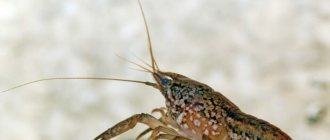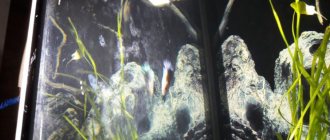Having first seen a fishing trophy two meters long and weighing 59 kilograms (Fig. 1), it is difficult to believe that fish of this species are not rare in home aquariums.
Rice. 1. Such a hefty catch went to two fishermen from Texas in 2004 (Photo by Clinton & Charles Robertson, under license CC-BY-SA)
However, it is true that at a young age, the Mississippi shellfish is a nice aquarium fish (Fig. 2), very similar to the familiar common pike.
Rice. 2. Armored pike in the aquarium of the Aqua Logo salon
In the United States of America, where this fish mainly lives, it is called Alligator gar. Scientific name: Atractosteus spatula. There are many popular names, for example, Mississippi shellfish, alligator pike. The similarity between the wide snout and long sharp teeth of the fish and the American alligator is really visible (Fig. 3).
Rice. 3. Mississippi alligator (
The Mississippi shellfish is a unique fish that lives and does not change for one hundred million years. These living fossils, along with rays and sharks, preserved the spirally curled fold of the midgut, as well as the ability to breathe not only in water, but also in air.
Habitat and appearance features
The armored pike belongs to the armored pike family. Its homeland is North America, however, this subspecies is occasionally found in the waters of South America. It is believed that the armored pike is one of the oldest animals that has gone through a huge evolutionary path. According to scientists, the first representatives of this species of predatory fish appeared about 7 million years ago.
Pike is characterized by its large size and very hard, dense scales, resembling diamonds in shape. The average size of an adult is about 1-1.5 m, so this fish is only suitable for very large aquariums or artificial reservoirs and ponds.
It has a torpedo-shaped body , an elongated muzzle with sharp, strong teeth . The armored pike looks extremely impressive due to its unusual color. The body of the fish has a light olive tint, and along it there are rich dark spots that form original, bizarre patterns.
It is noteworthy that, despite the fact that in its natural habitat the armored pike can reach 2 m, in aquarium conditions it stops growing. Moreover, the smaller the volume of the artificial reservoir, the faster the growth processes are inhibited. Aquarium armored pikes with a length of only 40-45 cm are quite common.
With its special structure, this fish differs from other subspecies. For example, segments of her spinal column only have one-sided depressions, not two-sided ones. Pike has a swim bladder, which helps normalize and maintain respiratory function. The jaw apparatus in appearance resembles a bird's beak; this structure allows the armored pike to capture and hold its prey before swallowing it.
The visual apparatus of this fish is also interesting. The pike has unique bipolar vision and all-round visibility, which is achieved thanks to its huge and very protruding eyes. The fins are very similar in appearance to sharks and are covered with sharp scales. Swimming in the aquatic environment, this large fish resembles a log, which is very convenient in terms of camouflage when hunting in natural conditions.
Spreading
The adjective “Mississippi” in the name of the fish indicates its main habitat. The natural distribution range is the lower Mississippi River, Gulf Coast of the southern United States and Mexico (Fig. 3).
Rice. 4. Distribution of the alligator gar in Central and North America. Source: discoverlife.org
Mississippi alligator fish prefer water bodies without currents or calm rivers. You can often find them in large rivers, as well as in brackish creeks. Shellfish, native to the Mississippi Basin, are more comfortable in salt water than other native fish species.
Several finds of the alligator gar have been recorded outside of America. Individuals ranging from one and a half to two meters in length were found in Turkmenistan, Hong Kong, Singapore, and India. It is believed that this is the result of the activities of aquarium enthusiasts and owners of private ponds.
Necessary conditions for keeping in an aquarium
The armored pike is a rather unusual fish, so it is not particularly suitable for beginners. It is best for experienced aquarists who understand how to properly handle predators to have such a bizarre pet. First of all, for the armored pike, due to its large size, you will need a large, voluminous aquarium, designed for 150 liters or more.
Since the animal is prone to solitude, the pond will need to be decorated in advance with dense thickets of algae and greenery. It is important to provide sufficiently bright, intense lighting and weak water flow. The optimal temperature regime can vary from +18 to +25°C. Recommended water hardness values are 8-17, and acidity values are pH 6.5-8.
Sufficient filtration and aeration are of great importance, which should also be taken care of before adding pike to the aquarium by purchasing powerful, high-quality devices. Due to the activity and strength of the armored pike, all decorative elements present in the aquarium must be very carefully secured, preferably fixed to the bottom.
It should be noted that armored pikes are quite active and mobile, especially at night, and often make attempts to jump out of the water.
For this reason, in order to avoid possible troubles and even death of the fish, it is necessary to cover the aquarium with transparent glass.
Commercial significance
The wild population of the carapace does not have serious commercial significance due to its small numbers. It is caught for the sake of extreme sports, sporting interest. Fishermen love to take pictures with their trophies, making sure to indicate their size. The decline in the population of the alligator gar has led to the need to regulate the catch. Alligator gar has a high yield of meat - white fillet and a small percentage of waste in relation to body weight. Gar caviar is poisonous, but the meat is sold to wholesalers as well as retail in supermarkets with prices starting at around US$7 per kilogram. There is also a small handicraft production of products made from fish skins such as bags, wallets, etc.
Shellfish are considered promising aquaculture targets, especially in developing regions. This is facilitated by rapid growth, disease resistance, easy adaptation of juveniles to artificial feed, and undemandingness to high water quality. And the ability to breathe atmospheric air eliminates expensive aeration systems and simplifies cultivation technologies typically used in aquaculture. Broodstocks have been established in the southern United States, Mexico and Cuba, and farmed fish have already become a popular food product there.
Nutritional Features
The armored pike is a predator by nature, which determines its diet. Ideal food would be worms, small fish, tadpoles, crustaceans or worms. However, frozen shrimp, squid and other seafood are also perfect. It is also possible to purchase ready-made specialized food, developed specifically taking into account all the characteristics and needs of the body of large predatory fish.
Some novice aquarists feed the armored pike with pieces of natural meat, but, according to experts, this is extremely undesirable. The fact is that the lipids contained in meat are poorly absorbed and tolerated by the body of the inhabitants of the aquatic world, which can provoke the development of obesity, indigestion and other diseases of the digestive system.
Feeding armored pike is a rather complex and unusual process.
You should only offer food to the fish using tweezers, since it will not feed from the bottom, and hand movements can provoke innate hunting instincts and lead to serious injuries to the aquarist.
Adults are fed 1-2 times a week. But young pikes should be fed more often in order to speed up their growth processes and ensure the full development of all internal organs and systems. Since pike are predominantly nocturnal, evening hours are considered the optimal time for feeding.
Siamese tiger perch - a reference predator
Siamese tiger perch (Indonesian) (lat. Datnioides microlepis) is a large, active, predatory fish that can be kept in an aquarium. Its body color is golden with wide black vertical stripes. In nature, tiger perch grows up to 45 cm in length, but in an aquarium it is two times less, about 20-30 cm. This is an excellent fish for keeping in a large aquarium, with other large fish. Siamese perches live in coastal rivers and swamps of Southeast Asia. As a rule, the number of stripes on the body can indicate the origin of the fish. Perches caught in Southeast Asia have 5 stripes, and on the islands of Borneo and Sumatra 6-7.
Habitat in nature
The Siamese tiger perch (formerly Coius microlepis) was described by Blecker in 1853. It is not in the Red Book, but abundant industrial fishing and fishing for the needs of aquarists have significantly reduced the number of fish in nature. They are practically no longer found in the Chao Paraya River basin in Thailand. Indonesian perch inhabits large bodies of water: rivers, lakes, and reservoirs. It sticks to places with a lot of snags. Juveniles feed on zooplankton, but over time switch to fry, fish, small shrimp, crabs, and worms. They also eat plant foods.
Description
Indonesian perch is a large, powerful fish, whose body structure is typical of a predator. The body color is very beautiful, golden with black vertical stripes running through the entire body. In nature, they can grow up to 45 cm in length, but in an aquarium they are smaller, up to 30 cm. At the same time, their life expectancy is up to 15 years. The tiger perch family (Datnioididae) contains 5 species of fish.
Difficulty in content
Suitable for advanced aquarists. This is a large and predatory fish, but as a rule it gets along well with fish of equal size. To keep them you need a spacious aquarium and brackish water, and they are also quite difficult and expensive to feed.
Feeding
Omnivores, but in nature they are mainly predators. They eat fry, fish, shrimp, crabs, worms, and insects. In an aquarium, Siamese perch should be fed mainly with live fish, although they can also eat shrimp, worms, and insects. One look at their mouth will tell you that there are no problems with the size of the food. They do not touch fish of equal size, but they will swallow any that they can swallow.
Keeping in an aquarium
To keep juveniles you need an aquarium, from 200 liters, but as the tiger perch grows, they are transferred to more spacious aquariums, from 400 liters. Since it is a predator and leaves a lot of debris as it feeds, the purity of the water is extremely important. A powerful external filter, soil siphon and water changes are absolutely required. They are prone to jumping, so the aquarium must be covered.
It is widely believed that this is a saltwater fish, but this is not entirely true. Tiger perches do not live in salt water in nature, but live in brackish water. They tolerate a salinity of 1.005-1.010 well, but a higher salinity will cause problems. A little salinity in the water is not necessary, but is advisable as it will improve their color and health. Although in practice, very often they live in completely freshwater aquariums and do not experience problems. Parameters for keeping: ph: 6.5-7.5, temperature 24-26C, 5 - 20 dGH. Tiger perch, stingray, armored pike in a species aquarium In nature, Siamese tiger perches live in places with an abundance of flooded trees and snags. They hide in the bushes, and their bloom helps them do this. And in the aquarium they need to be provided with places where they can hide in case of fright - large stones, snags, bushes. However, you shouldn’t get carried away with the decor either, since such an aquarium is difficult to care for, and tiger perches create a lot of garbage while feeding. Some aquarists generally quite calmly keep them without decoration.
Compatibility
Not aggressive with fish of equal size. All small fish will be eaten quickly. It is best kept in a separate aquarium, as the Indonesian tiger perch has specific water salinity requirements. Neighbors like monodactyls or argus require more salty water, so they cannot live with them for a long time.
Breeding
It was not possible to breed Thai tiger perches in a home aquarium; all fish were caught in the wild. Now they are bred on farms in Indonesia, however, how remains a secret.
catfishes.ru>
Behavior and compatibility with other aquarium inhabitants
Armored pikes tolerate loneliness well, so it is best to keep them alone in the aquarium, especially since due to their large size it is quite difficult to find an artificial reservoir of suitable volume.
When deciding to keep an animal in the same aquarium with other aquatic inhabitants, it is important to take into account their natural hunting instincts and avoid proximity to small fish. The optimal neighbors for the armored pike will be large representatives of the aquatic world:
- arowanas;
- American cichlids;
- knife fish;
- sturgeon;
- polypterus;
- piranha pacu;
- sacbranch or chain catfish;
- tilapia.
The most important thing is that the fish are large enough to avoid their possible absorption by the armored pike. It is strictly not recommended to stock predatory fish in the same tank with shrimp, clams, mussels, and small peaceful fish, as they will be destroyed by the predator literally within 24 hours.
In terms of behavior, armored pikes are rather phlegmatic and calm. They are active when hungry, during hunting, or when potential prey comes into view. At times they like to swim in the upper layers of water. They lead a nocturnal lifestyle and it is during these hours that they become most active.
Killie fish
These carp-toothed fish are called Killi Fish.
In terms of their elongated body shape, they resemble pikes. Their natural habitat is small lakes and streams, particularly dry ones. Therefore, they are unpretentious and accustomed to poor external conditions. Average aquarium species reach 10 cm. They are conventionally classified into seasonal and non-seasonal.
The most dominant individuals have gold, red, yellow, bright green and orange colors. Killi Fish that combine several colors are often found.
Killifish coexist favorably with other fish and with their own kind. They coexist harmoniously with moderate and calm relatives with similar character, behavior and approximately the same size.
Killi Fish become aggressive during the breeding season. Pike treat neighbors with whom they have been cohabiting for a long time favorably and do not conflict, but new residents can bring discord and anxiety into the calm life of the animals.
These fish consume live food, preferably floating on the very surface of the water. They feed on chopped tubifex, cyclops, coretra, chopped bloodworms will do.
You should try to feed the inhabitants of the aquarium twice a day. Fish are not adapted to dry food, but for a while you can switch to frozen food. There is no need to overfeed pikes, this harms them, and any remaining food should be removed from the tank.
We should not forget that fish (including aquarium pike) need a varied diet, and the individuals of the aquarium world will always be healthy.
Basic care requirements
In order for the armored pike to feel as comfortable as possible in the aquarium, to be healthy and live a long time, it is necessary to follow a number of care recommendations:
- Daily check of the operation of filters, aerators, heating and lighting devices. After all, if they break, the basic water parameters necessary for the health and full functioning of the armored pike will not be met.
- Regular cleaning of water filters.
- Change the fluid in the aquarium by at least 30%, at least once a week.
- Use only high-quality and clean water, without chlorine and other chemically harmful, toxic substances to which armored pikes are extremely sensitive and susceptible.
- Cleaning the soil from waste products, as well as food residues and other contaminants (read more about how to properly siphon soil in an aquarium).
Following these simple rules will prevent the development of a number of dangerous diseases.
Purchasing a fry
Pike fry can be purchased from specialized farms, or you can raise them yourself.
Using artificial fertilization of eggs, you can get 10 times more fry than naturally in the wild. During artificial breeding, fewer pike larvae die.
Read also: What are the people who grow grapes called?
To create the necessary conditions for the life of the eggs, they are kept in special glass containers. Thus, the fry is born after 10 days. For comparison, in the natural environment this process occurs within 1 month. The head of the fry is difficult to see, because part of it closes the gallbladder, which contains nutrients to ensure vital functions for the near future. After 30 days, the fry grow up to 5 cm in length and begin to actively search for food.
In fish farms, you can keep a population of productive fish, from which you can obtain planting material for stocking the pond with pike. To breed fingerlings and further select viable and rapidly developing individuals, fish must be caught in large feeding ponds and reservoirs.
At 1 year of life they are kept in ponds along with carp. Large and medium-sized individuals are selected for breeding. It would also be advisable to select only females that grow much faster than males (it is possible to determine their gender in the autumn season by the presence of reproductive products during autopsy). Having determined the weight of males per large female, it is necessary to select 5 fingerlings with the weight characteristic of males.
Next year they can be kept in ponds for breeding carp broodstock. Thus, adult pikes will eat crucian and carp fry.
The required number of pike breeding stock for a farm is calculated depending on the demand for fry for breeding in artificial ponds. The spawning characteristics of these fish are also taken into account. In the natural environment, no more than 5,000-10,000 fry are produced from 1 nest.
With natural fertilization, there are at least 3 males per 1 female. Using the milk of a killed male (weighing 175 g), up to 50 females can be fertilized. To do this, you need to simultaneously pour the ripened caviar and milk into an enamel bowl. After 30 seconds, you need to stir the eggs using a bird feather. After this, you need to add water and stir again after 15 seconds (so that the duration of fertilization does not exceed 1 minute).
The process of domestication and taming of the armored pike
To tame the armored pike and make it a peace-loving pet is an unrealistic task, due to the pronounced hunting instincts inherent in nature itself. All armored pikes that end up in artificial reservoirs are caught in their natural environment, since they do not reproduce in aquarium conditions.
It is recommended to purchase such aquatic representatives in the summer, since sudden temperature changes can become a strong stress factor and even cause the death of fish.
The most important thing is to provide the armored pike with a sufficient volume of water in the aquarium.
At first, it is better to house the animal separately, even if in the future it is planned to live with other aquarium inhabitants. Indeed, at first, an armored pike that has just been caught from its natural environment, accustomed to obtaining food by hunting and protecting itself from the attacks of other predators, will certainly behave quite aggressively.
The armored pike is an unusual and interesting aquatic inhabitant, which, despite its predatory, aggressive nature, gradually adapts to new conditions and becomes an excellent decoration for any aquarium.
Reproduction
The alligator gar has a long life and matures late. Most females reach sexual maturity in the second decade of life, males mature earlier. Preparation for spawning begins in the spring with an increase in photoperiod, temperature and water level during the rainy season. Overflowing rivers inundate terrestrial vegetation, providing protection and nutritious habitat for larvae and juveniles. When the water temperature reaches approximately 23 °C, mature individuals move to the grassy shallows. Spawning takes place here. The fertility of females is high - 4.1 eggs per gram of body weight. The eggs of the female and the sperm of one or more males are released in the water column, the sticky fertilized eggs sticking to the submerged vegetation. After a couple of weeks, the independently living fry already feed on plankton, invertebrates, amphibians and fish.











